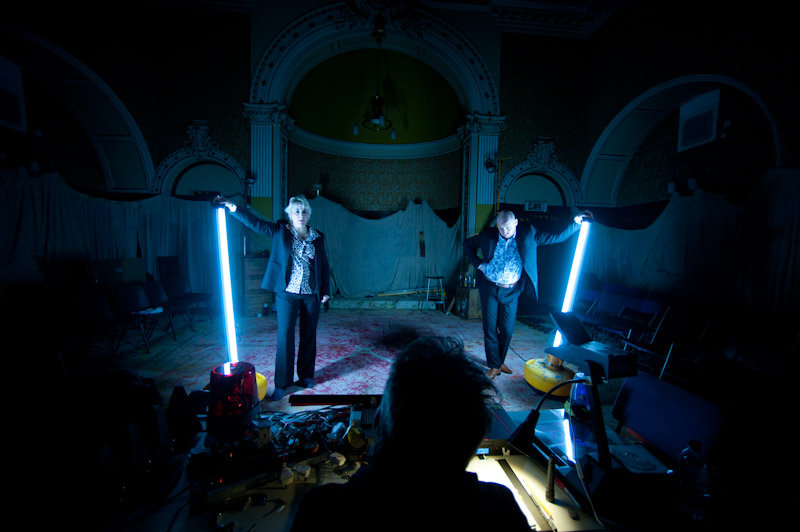Stage backdrop, floor and even the audience seating are covered with paint-splattered canvas. It’s like sitting in the middle of a Jackson Pollock painting. Although we are seated in a regular theatre space, I read in the script notes that the author (David Leddy) envisions it as set in an art gallery or disused warehouse. Both of which would be very appropriate to the subject matter, which we’ll get to later. A man and a woman are fidgeting round the space, nodding along to the kitsch, screechy Yma Sumac tunes on the soundtrack. A technician at his desk is placed upfront, in the performance space. And off we go, into a rip-roaring and hearty tale about a pair of con-artists, a husband and wife team called Jim and Liz who, when their stock goes up in smoke, switch from the fake vintage handbag business to art forgery. Although what exactly do we mean by a fake, a forgery? The deliberately distressed vintage handbag is a real bag, it isn’t fictional; the forged paintings are done by real artists using real paint.
But nothing is real about these two, we are lead to believe. ‘We tell lies for a living’ they say (and yes, we get the irony – that’s what actors do, you could argue). This fake existence, an existence living a lie, is played out dramaturgically by deft switches in accents and indeed roles as storyteller and character constantly swap skins – he plays her, she plays him, and they both play other people. Meanwhile, the technician plays author David Leddy, who allegedly heard this story verbatim – but plays him badly, you understand, because he’s not an actor. The innate fakeness of theatre is played with and challenged by the lighting and technical choices: lights are mostly household or builder/decorator lamps; the technician’s actions throughout are upfront and visible, not hidden. There’s also a slightly silly pretence of electrical faults causing interruptions in the action. The characters are aware of their own theatricality, so yes, it’s meta-theatre (and yes, Derrida does get mentioned somewhere along the way).
The game is that the boundaries between the fake and the real shift all the time. The goodies in the story turn out to be the baddies and vice versa. Who’s conning whom? It’s impossible to tell. Ultimately, it’s a redemption story: the crooks come good, and find salvation (bizarrely) in rescuing trafficked sex workers. They manage this by doing something they’ve never done before: using their real names and real passports to leave the country.
There are many narratives and threads of investigation that weave through and round the central story. The much-touted theme of castration in the play is played off against a theme of female infertility, which is linked in to a running thread about adoption and never knowing who you really are (do any of us?).
The design is great – I love the canvas, the hand-numbered ‘original artwork’ programmes, the lighting choices. I love the onstage technician. The dialogue is sharp as a butcher’s knife. I find the ‘theatre constantly referencing itself as theatre’ mode a wee bit passé and a little irritating – whilst of course understanding that in a show about the ‘real’ and the ‘fake’ going down that route is a temptation hard to resist. But for my part, having the mechanics of the theatrical process and the role swapping / accent swapping would have done the job without hammering it home in the text too.
It’s very well written and performed with pizzazz, a rumbustuous romp that works on many different levels. Despite the fact that castration, miscarriage, sex trafficking, and the sexual abuse of children all feature in the story, it’s ultimately a feel-good play, feeding us the notion that there is the potential for salvation in all of us, no matter how far we might have strayed down the wrong path.

